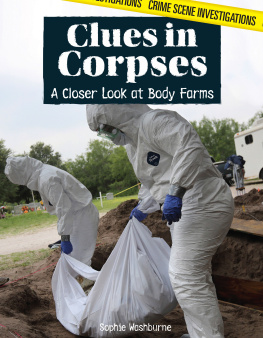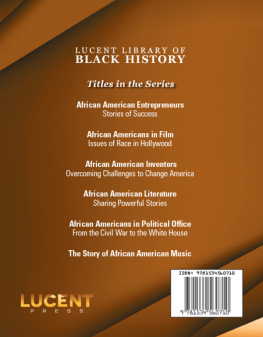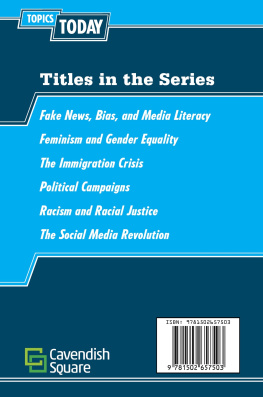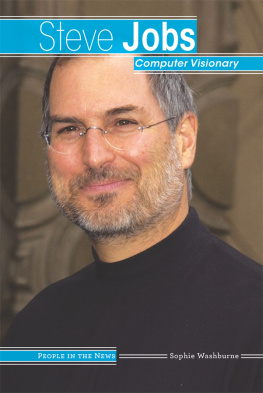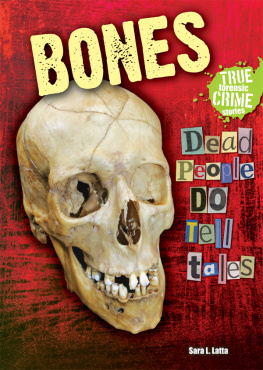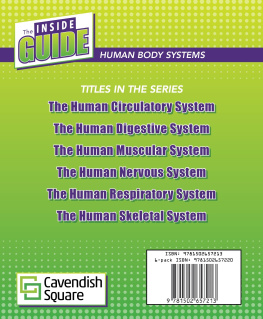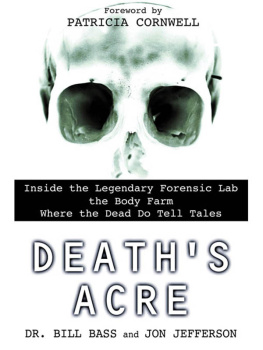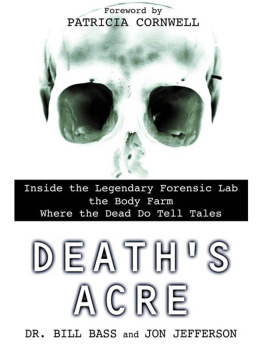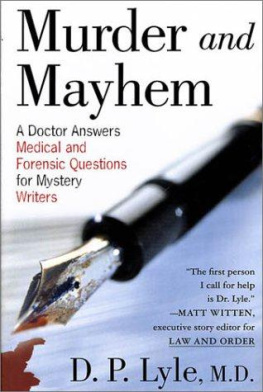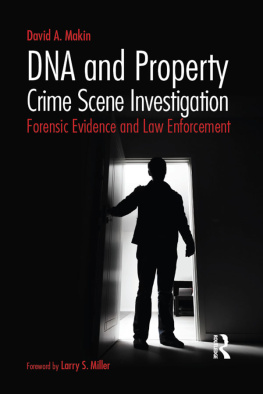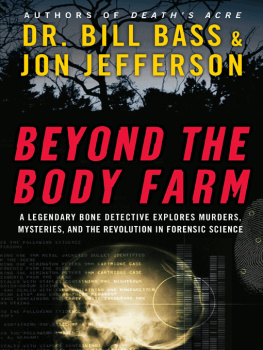- Introduction:
Creepy or Cool? - Chapter One:
Learning from a Mistake - Chapter Two:
Inside the Body Farms - Chapter Three:
Making Important Discoveries - Chapter Four:
Down to the Bone - Chapter Five:
Technological Advancements - Chapter Six:
The Future of Body Farms
Published in 2018 by
Lucent Press, an Imprint of Greenhaven Publishing, LLC
353 3rd Avenue Suite 255
New York, NY 10010
Copyright 2018 Greenhaven Press, a part of Gale, Cengage Learning
Gale and Greenhaven Press are registered trademarks used herein under license.
All new materials copyright 2018 Lucent Press, an Imprint of Greenhaven Publishing, LLC.
All rights reserved. No part of this book may be reproduced in any form without permission in writing from the publisher, except by a reviewer.
Designer: Deanna Paternostro Editor: Jennifer Lomardo
Cataloging-in-Publication Data
Names: Washburne, Sophie.
Title: Clues in corpses: a closer look at body farms / Sophie Washburne.
Description: New York : Lucent Press, 2018. | Series: Crime Scene Investigations | Includes index. Identifiers: ISBN 9781534562714 (pbk.) | ISBN 9781534561724 (library bound) | ISBN 9781534562318 (ebook)
Subjects: LCSH: Human decomposition-Research-Tennessee-Juvenile literature. | Human skeleton-Analysis--Juvenile literature. | Forensic osteology--Tennessee--Juvenile literature. | Crime laboratories--Tennessee--Juvenile literature. | Forensic anthropology--United States--Juvenile literature.
Classification: LCC QP87.W37 2018 | DDC 599.9-dc23
Printed in the United States of America
CPSIA compliance information: Batch #CW18KL: For further information contact Greenhaven Publishing LLC, New York, New York at 1-844-317-7404.
Please visit our website, www.greenhavenpublishing.com . For a free color catalog of all our high-quality books, call toll free 1-844-317-7404 or fax 1-844-317-7405.
Contents
Introduction:
Creepy or Cool?
Chapter One:
Learning from a Mistake
Chapter Two:
Inside the Body Farms
Chapter Three:
Making Important Discoveries
Chapter Four:
Down to the Bone
Chapter Five:
Technological Advancements
Chapter Six:
The Future of Body Farms
Foreword
F or decades, popular television programs and movies have depicted the life and work of police officers, detectives, and crime scene investigators. Many of these shows and films portray forensic scientists as the brains responsible for cracking cases and bringing criminals to justice. Undoubtedly, these crime scene analysts are an important part in the process of crime solving. With modern technology and advances in forensic analysis, these highly trained experts are a crucial component of law enforcement systems all across the world.
Police officers and detectives are also integral members of the law enforcement team. They are the ones who respond to 911 calls about crime, collect physical evidence, and use their high level of training to identify suspects and culprits. They work right alongside forensic investigators to figure out the mysteries behind why a crime is committed, and the entire team cooperates to gather enough evidence to convict someone in a court of law.
Ever since the first laws were recorded, crime scene investigation has been handled in roughly the same way. An authority is informed that a crime has been committed; someone looks around the crime scene and interviews potential witnesses; suspects are identified based on evidence and testimony; and, finally, someone is formally accused of committing a crime. This basic plan is generally effective, and criminals are often caught and brought to justice. Throughout history, however, certain limitations have sometimes prevented authorities from finding out who was responsible for a crime.
There are many reasons why a crime goes unsolved: Maybe a dead body was found too late, evidence was tampered with, or witnesses lied. Sometimes, even the greatest technology of the age is simply not good enough to process and analyze the evidence at a crime scene. In the United States during the 20th century, for example, the person responsible for the infamous Zodiac killings was never found, despite the earnest efforts of hundreds of policemen, detectives, and forensic analysts.
In modern times, science and technology are integral to the investigative process. From DNA analysis to high-definition surveillance video, it has become much more difficult to commit a crime and get away with it. Using advanced computers and immense databases, microscopic skin cells from a crime scene can be collected and then analyzed by a forensic scientist, leading detectives to the home of the culprit of a crime. Dozens of people work behind the scenes of criminal investigations to figure out the unique and complex elements of a crime. Although this process is still time-consuming and complicated, technology is constantly improving and adapting to the needs of police forces worldwide.
This series is designed to help young readers understand the systems in place to allow forensic professionals to do their jobs. Covering a wide range of topics, from the assassination of President John F. Kennedy to 21st-century cybercriminals, these titles describe in detail the ways in which technology and criminal investigations have evolved over more than 50 years. They cite eyewitnesses and experts in order to give a detailed and nuanced picture of the difficult task of rooting out criminals. Although television shows and movies add drama to the crime scene investigation process, these real-life stories have enough drama on their own. This series sticks to the facts surrounding some of the highest-profile criminal cases of the modern era and the people who work to solve them and other crimes every day.

W hen people hear the words body farm, their first reaction may be confusion. Body farms are not talked about much, so people may not know what they are. Some people think they are places where murderers bury their victims bodies; others think they exist so organs can be harvested; still others think they are locations where victims are lured to be murdered. When people find out what body farms actually are, they are generally either disgusted or interested to learn more.
Body farms are research facilities where forensic experts study bodies to learn how they decompose, or break down, under different circumstances. Forensics is the use of science in crimesolving; according to the College of American Pathologists, forensic scientists are experts in investigating and evaluating cases of sudden, unexpected, suspicious and violent death, as well as other specific classes of death defined by state laws. However, to understand the results of their investigations, forensic scientists must be familiar with the ways bodies decompose, which is why body farms are important.
Fear and Outrage
There are several reasons why people may disapprove of body farms. One reason is some people feel it is not respectful to the bodies or to the people who may accidentally see them. For example, when a young man in Knoxville, Tennessee, found a body decomposing near the site where he and his coworkers were laying out boundaries for a new parking lot in 1985, he was shocked and disgusted. That night, he told his mother about his unpleasant experience. She, too, was shocked and, being a leader of a local advocacy group called Solutions to Issues of Concern to Knoxvillians (S.I.C.K.), decided to take action. Within days, members of S.I.C.K. rallied to voice their disapproval, holding a demonstration outside the facility at the University of Tennessee Medical Center and carrying signs that read, This Makes Us S.I.C.K. The group was especially indignant that such experiments were being carried out in plain view of the general population.
Next page
